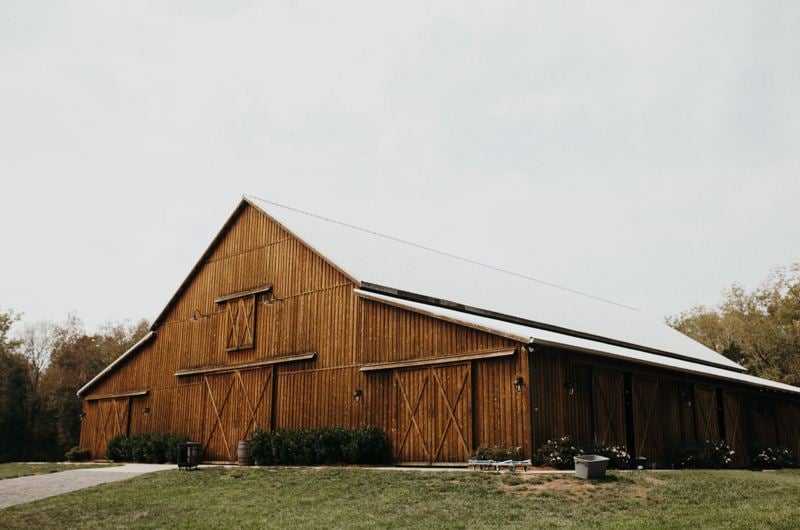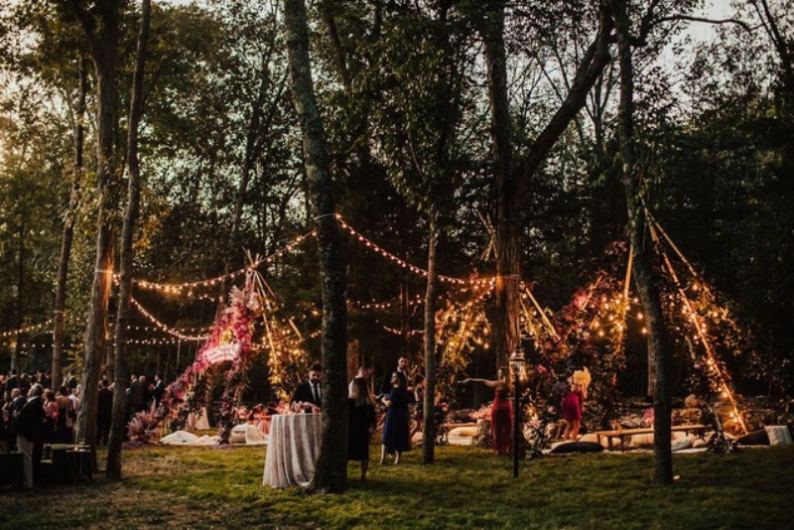
photography credit: Jordan Voth Photography
Hosting a wedding in the country offers a distinct, understated event that draws on the natural surroundings and simplicity of rural landscapes. Whether it’s an open field, a barn, or a secluded farm, the setting allows for a more personal and intimate celebration away from the formality of traditional venues. It is also a way to save money and utilize a personal or family-owned location that is special to you. With the right planning, a country wedding can seamlessly incorporate thoughtful details with the landscape, creating an event that feels both simple and beautiful. Considerations such as transportation, local regulations, and the weather help ensure that the beauty of the setting is matched by smooth execution. Here are the primary steps you need to follow when planning a rural wedding:
1. Use rental services with personal contributions for building a venue from scratch
A local rental company will be invaluable for providing tents, chairs, tables, and even a dance floor. In addition to rentals, some structures will likely need to be custom built on-site at the rural location. Communication and frequent meetings with vendors are essential, as they will need to understand the logistical demands of working in a remote field setting. Many rural weddings involve personal touches, like homemade bars or custom shelving, crafted specifically for the occasion. These details often come together as a collaborative effort, with family and friends pitching in, whether by building structures or providing services like photography or catering.

photography credit: Jordan Voth Photography
2. Work with professional vendors as well as seek help from family and friends
Building a wedding venue from the ground up, with no pre-existing infrastructure, creates a truly unique and personal experience. Every detail, from the decor to the setup, reflects the couple’s vision and the collective efforts of their loved ones. While challenging, the end result is a one-of-a-kind celebration that feels truly meaningful and personal.
3. Plan out the easiest and most convenient transportation options for guests
Planning guest transportation for a rural wedding is essential to ensure everyone arrives safely and on time, particularly if the venue is remote and lacks easy access. Given the location, it’s important to assess road conditions—dirt roads or uneven terrain can be challenging for certain vehicles. Hiring shuttles or buses to transport guests from a central meeting point, such as a nearby town or hotel, can help alleviate confusion and ensure no one gets lost. Clear communication is key, so providing guests with detailed directions, maps, and signage along the route is a must. For those driving themselves, consider organizing parking in a designated area and having attendants on hand to guide guests and keep things orderly. Proper planning will make transportation seamless, reducing stress for guests and allowing them to focus on enjoying the celebration.

photo credit: Jordan Voth Photography
4. Incorporate signage into the location for easy navigation
5. Use trailers for hauling equipment to the location and needed accessibilities on-site
Hosting a rural wedding in the country, especially in a location with no running water or electricity, requires careful planning and creativity. When creating a venue from scratch, you’ll need to bring in everything from trailers to haul essential items to a portable bathroom trailer for guest comfort. Organization is key, with different people responsible for separate tasks to ensure everything runs smoothly. One challenge is guiding vendors to the remote location; meeting them on a main road and leading them to the site is crucial, and creating clear, visible signs to direct guests and deliveries is a must.
6. Research local regulations to take into consideration
Considering local regulations is a critical necessity when planning a rural wedding, especially when using property that is not your own. Zoning laws, environmental regulations, noise ordinances, and permits for temporary structures like tents or stages may all come into play, depending on the area. Some locations require special permits for gatherings over a certain size or for the use of open fields as event spaces. Additionally, health and safety regulations might dictate the number of portable bathrooms needed or where food can be prepared and served. It’s important to contact local authorities early in the planning process to ensure compliance and avoid any last-minute issues that could disrupt the event. Properly addressing these regulations not only ensures the event runs smoothly but also protects everyone involved from potential fines or legal complications.
7. Consider possible accommodations for unexpected weather
Accommodating for weather at an outdoor wedding requires proactive planning. Renting a tent or canopy provides shelter from unexpected rain or harsh sunlight. Choose a tent with sides that can be rolled up or down depending on the forecast, and consider flooring to prevent mud in case of wet conditions. Have portable heaters or fans on standby for temperature fluctuations, and stock up on blankets or umbrellas for guests if needed. Always have a backup indoor location or a sturdy shelter nearby to relocate the event if severe weather is expected, ensuring the wedding can proceed smoothly regardless of conditions.

photography credit: Jordan Voth Photography
by: Ashley Hundt





